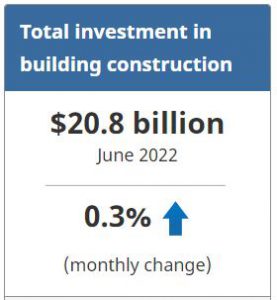Statistics Canada: Investment in Building Construction, June 2022
Investment in building construction edged up 0.3% to $20.8 billion in June. Gains in the non-residential sector (+2.4%) helped keep overall investment up. The majority of strength for the month came from Ontario, reporting gains in all building components following a weak May resulting from a construction workers strike in the province.
On a constant dollar basis (2012=100), investment in building construction declined 0.6% to $12.5 billion.
Residential construction breaks growth streak
Despite six provinces reporting growth, residential construction investment declined 0.4% to 15.5 billion in June, with Quebec (-6.7%) causing most of the fall. This was the first decline in nine months for residential investment.
Multi-unit construction investment fell 1.6% to $6.9 billion in June. Despite this decrease, investment in multi-unit construction has shown an overall upward trend since October 2021.
Investment in single-family homes continued to show strength, having outpaced multi-unit construction since the COVID-19 pandemic downturn. It increased 0.7% to $8.6 billion in June, with gains in six provinces.
Non-residential sector rebounds in June
Non-residential construction investment increased 2.4% to $5.3 billion in June.
Commercial investment advanced 2.7% to $3.0 billion, led by Ontario (+4.1%). After falling for the first time in 13 months in May, as a result of Ontario construction workers strike, the commercial component made up for the temporary decline and continued its upward trend.
Institutional construction investment rose 0.7% to $1.4 billion with six provinces reporting gains, led by Ontario (+3.8%).
Investment in the industrial component increased 3.7% to $974 million, the highest monthly value increase since May 2020, just after pandemic-related shutdowns.
Second quarter of 2022 in review
The total value of investment in building construction rose 3.3% to $62.3 billion in the second quarter, the third consecutive quarterly increase. Investment for residential buildings reached $46.4 billion, largely due to increased spending on multi-unit construction. The non-residential sector rose 2.6% to $15.8 billion.
Ontario’s growth in the second quarter remained flat when compared with the first quarter of the year, with the strike impacting investment in all components. Industrial construction was the only component to show notable growth for this province.
Residential investment in the single-unit component increased for the third quarter in a row, rising 2.6% for the quarter to $25.7 billion. The multi-unit component has increased for the previous three quarters, rising 4.5% this quarter, with most of the growth coming from Quebec.
Investment in the non-residential sector was up 2.6% to $15.8 billion, continuing growth from the previous quarter. The commercial component, which contributed the most to the non-residential sector, gained 2.8% to $8.8 billion, its fifth consecutive quarterly growth. Institutional construction edged up 0.5% to $4.2 billion, up for the sixth consecutive quarter. The industrial component rose 5.4% to $2.9 billion, with Ontario (+8.3%) leading the gains.
For more information on housing, please visit the Housing statistics portal.
Note to readers
Unadjusted data for the current reference month are subject to revision based on late responses. Unadjusted data has been revised for the previous five months to incorporate new municipalities from the 2021 Census of Population. Seasonally adjusted data has been revised for the same time period.
Data presented in this release are seasonally adjusted with current dollar values unless otherwise stated. Using seasonally adjusted data allows month-to-month and quarter-to-quarter comparisons by removing the effects of seasonal variations. For information on seasonal adjustment, see Seasonally adjusted data – Frequently asked questions.
Monthly estimates in constant dollars are calculated using quarterly deflators from the Building Construction Price Index (table 18-10-0135-01). Typically, the first two months of a quarter use the previous quarter’s price level, and the data are revised when the new quarterly price index becomes available.
Detailed data on investment activity by type of building and type of work are now available in the unadjusted current dollar series.
Next release
Data on investment in building construction for July will be released on September 13.
Products
Statistics Canada has a “Housing Market Indicators” dashboard. This web application provides access to key housing market indicators for Canada, by province and by census metropolitan area. These indicators are automatically updated with new information from monthly releases, giving users access to the latest data.
Source: Statistics Canada


